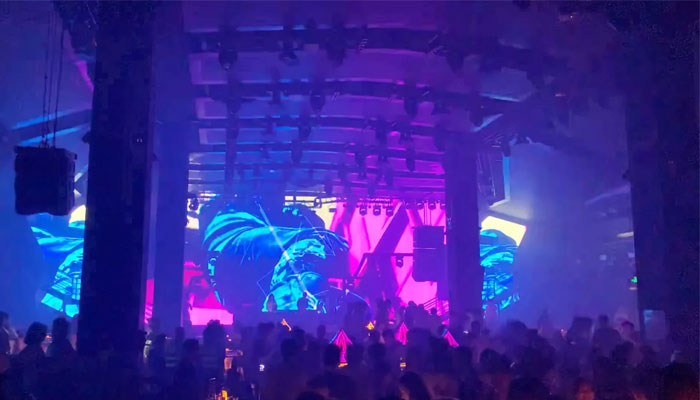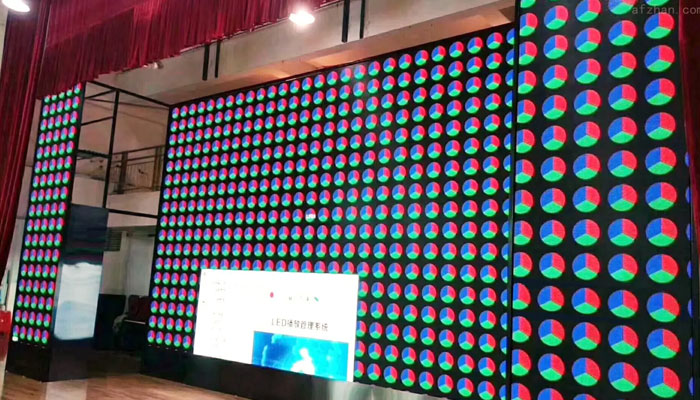With the development of science and technology, the emergence of LCD screens transparent has gradually replaced the original ordinary LCD splicing screen, projection and other equipment. HOLA-LED, as an LED and LCD manufacturer, has taken the lead in introducing transparent screen solutions in the industry. I hope that through this article It can help you better understand the application of various transparent products. Without further ado, let’s get straight to the point!
1. LCD transparent screen solution
The so-called LCD transparent screen is not a new technology. It has appeared for a long time. The most well-known application is the transparent box display cabinet.
Regarding the basic principle of LCD transparent screen, it is actually an incomplete LCD screen or a semifinished screen. At the beginning, an engineer had a whim and an application mode invented by removing the backlight unit behind our normal screen, that is, placing the object to be displayed between the backlight unit and the display layer (in the backlight box). The reason why it is necessary to have a box is to use the rear box as a backlight unit, otherwise the screen cannot be displayed normally.
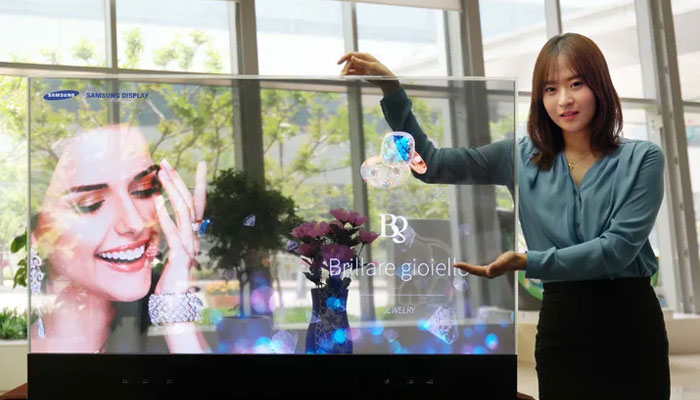
Some notes on using it:
It is not a self-luminous technology, and a backlight must be used as a supplement;
It is not transparent in the non-energized state, that is, the color of the liquid crystal layer itself, black;
In the power-on state, the white background must be made to be transparent, and only the white background can ensure that the liquid crystal layer allows more light to pass through;
It can be spliced and the size is rich, but limited by the physical factors that the three sides are narrow and the other is wide, the splicing can only achieve 2*N or N*2 splicing methods. The picture below is a 2*3 splicing, because there is a particularly wide non-transparent area due to the cable and board at the bottom of the screen. In order to narrow the horizontal seam, the upper line of the screen is actually spliced upside down, and the top and bottom cannot be increased, because the splicing The seam can no longer be made very narrow, which is not acceptable;
The lighting must be arranged evenly, otherwise it will affect the viewing effect. If the exhibits in the cabinet are too large, it needs to be properly supplemented;
If you want to use touch, it is more convenient to apply infrared touch.
2. OLED transparent screen solution
OLED has been popular in the past two years. Samsung did it in the early years, but now it seems that only LG is playing. The technology is actually not complicated, but only a few people really understand it. The most straightforward is self-illumination. It is this feature that makes it have the advantages that backlight products and projectors do not have, and do not care about light requirements. The principle is as follows :
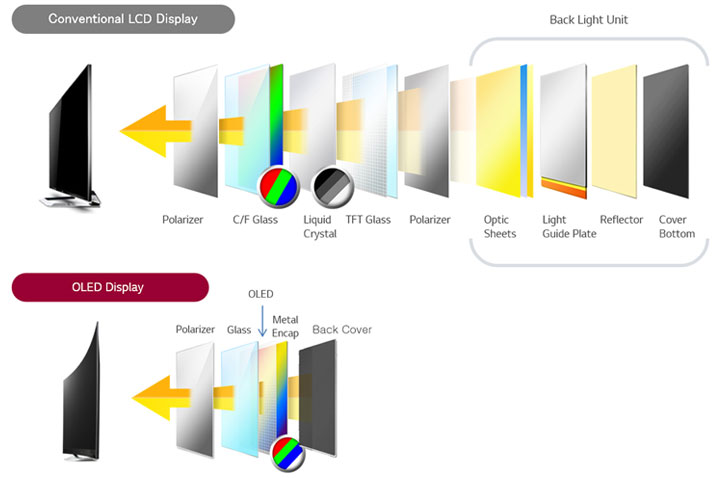
OLED has fewer backlight units in the red frame than LCD, which greatly reduces the thickness of the screen. It is precisely because OLED uses self-luminous technology, and the circuit and display light-emitting unit are made of transparent or nearly transparent materials (this is why it cannot be 100% transparent, only 38% light transmittance), so it can be done. Thin and light, less restricted by light, more technological sense. The scalability is better than that of the LCD liquid crystal screen, because there is no burden on the shell, it can be combined with various mechanical equipment for various transformation applications.
Precautions:
It is not suitable for outdoor use. Although it is self-illuminating, it still does not have the strength of LED to fight against the sun;
It can be used independently without the same box as the LCD screen. The difference when displaying the goods is as follows;
The left side is OLED, the right side is LCD. In other words, it is a bit troublesome to put the car in the box, haha!
Like the LCD transparent screen, limited by physical conditions, it can only achieve 2*N or N*2 splicing methods;
The material production is just the opposite of the LCD transparent screen, which needs to be black, which is related to their imaging principle;
The scene behind the screen would be better if the light was a little brighter.
There are many choices of single-screen touch solutions, and infrared touch is also mainly promoted after splicing.
These application scenarios are only achievable with OLED screens
3. LED transparent screen solution
It is only one less O than OLED, but the application is very different. It can be said that the main application scenarios of LED are fundamentally different from OLED. LED transparent screens are mainly used in conditions that do not require close viewing, such as outdoors or indoor large-area partition walls, which is also due to its low pixels. The principle of transparency should be understood by those who have seen the blinds. It is to widen the distance between the pixels and leave a gap so that you can see the back. As for how to leave a gap and how to fix it, each has its own method. . And LEDs even look a bit like blinds.
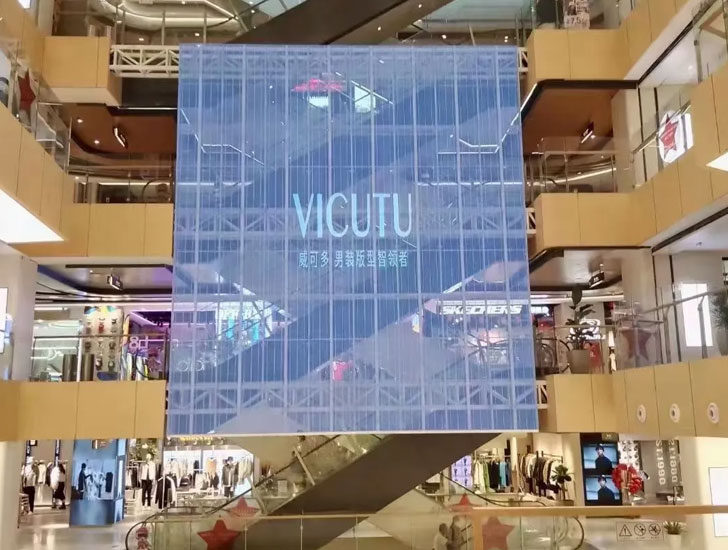
A simple summary of the application scenarios and constraints of LED transparent screens is that the pixel requirements are not high, and it is definitely the right choice for outdoor use. Another thing that LCD and OLED transparent screens can’t compare with is that they can be spliced infinitely, as long as you have the money, as long as you have enough space.
4. Photonic chip projection
What the hell is this? The principle will be more complicated than the previous ones, that is, the specially treated projection film makes the transmittance higher, looks more transparent, and has higher reflectivity, allowing more light to enter your eyes, so compared with the previous holography The projection film has more vivid colors, better brightness and more transparency.
On the right is the photon projection film on the tall tower. Is it like a piece of glass?
The application scenarios and constraints can be summed up in two points, light: after all, it is still projection, or the environment is too bright; silhouette: suitable for front projection, it is inevitable that if people are too close, there will be shadows. Also, this technology has the advantage of not being limited in area.
Finally, by summarizing what we have talked about before, we can find that the four transparent technologies have their own strengths and weaknesses in the application of actual exhibitions. They are briefly listed as follows:
LCD transparent screen:
Advantages: high cost performance, mature technology, flexible size, convenient production;
Disadvantages: There must be a light source to supplement, subject to the box, and the application flexibility is limited.
OLED transparent screen:
Advantages: Self-luminous, less bound by the light source, no box is required, the screen is light and thin, and there are various forms of extended applications;
Disadvantages: There is only one size, the price is high, why not talk about cost performance, because it is really beautiful when done!
LED transparent screen:
Advantages: can be used outdoors, unrestricted splicing, high brightness;
Disadvantages: Low pixels are not suitable for indoors, and the rear rack is more obvious.
Photon Projection:
Advantages: high permeability, good integrity, not restricted by area;
Disadvantages: light, still afraid of strong light, there will be shadow problems in front projection;



